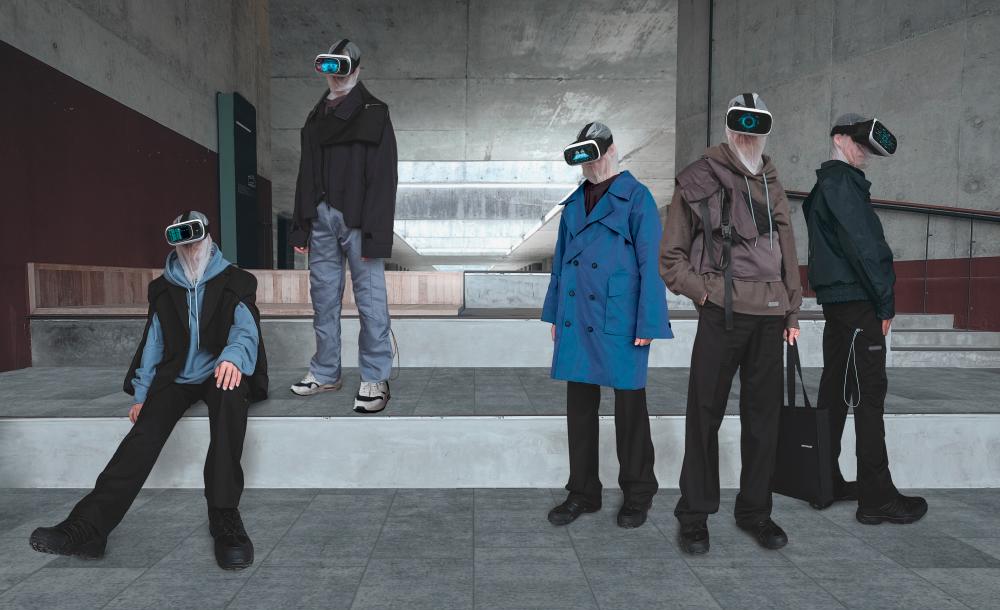THE virtual identity and cyber aesthetic of the digital milieu are the founding principles of emerging fashion label NotInList. Here, fashion in the digital space displays a new manifestation of non-conformist expression.
Established by video game artist-turned-fashion designer Xavier Ou, NotInList delivers something of a different perspective.
He explains: “My concept of fashion was pretty much about weird, out-of-this-world runway shows, but the more I explored ... it became a means of expression for the artistic self; a non-verbal way of communication. There is also a philosophical aspect of fashion that complements my interest in video games.
“However, I wouldn’t consider NotInList as a streetwear brand, it doesn’t quite fall in line with the aesthetic or the attitude of what streetwear stands for.”
The self-taught fashion designer also looks up to the likes of great fashion designers Demna Gvasalia, Yohji Yamamoto, Matthew Williams, Samuel Ross, Rick Owens and Helmut Lang for their conceptual thoughts and referential approach.
It was they who articulated the language of anti-fashion and deconstructionism, giving way to a subverted modern relevance. They influenced a new generation of designers, including Ou himself.
He reveals the intertextual relationship that fashion has in the digital realm as something more than a conduit for concepts to narrate an obsessive mood or subversive idea.
“It has been known for fashion houses or designers to collaborate on video games. It creates a virtual experience that physical clothing cannot offer, and in this case, also blurs the line between fashion and video games.
“There is also a technical breakthrough when fashion is applied or converted into the dimension of virtual geometry.”
For instance, Prada-clad Final Fantasy characters were featured in Japanese men’s fashion magazine Arena Homme+, wearing the brand’s Spring 2012 menswear collection, and during Marc Jacobs 2013 tenure at Louis Vuitton, he created high-fashion outfits for the popular Japanese hologram singer Hatsune Miku.
And most recently, characters in the video game League of Legends have been given a luxurious makeover by Louis Vuitton, under Nicolas Ghesquière’s creative direction.
These collaborations blend real-world fashion into the virtual world, and involve storytelling elements that play like a movie to immerse the player.
Informed by his studies in both 3D game art design and digital illustration, Ou puts the ‘fun’ in ‘functional high-tech style’ with his debut Spring/Summer 2019 collection Outer Heaven, a name riffing on philosophical concepts from the classic video game Metal Gear Solid. The collection seamlessly incorporates fictional elements of sci-fi clothing – otherwise far too impractical to wear down a city sidewalk – into everyday basics.
Nonetheless, the collection showcased NotInList’s utilitarian approach to fashion. Much of its pieces take the form of sport utility wear, including field jackets, tracksuit trousers and t-shirts, which are designed as a form of athleisure wear, taking into account mobility and flexibility.
NotInList’s Autumn/Winter 2019 collection named Virtual Rising, however, was a departure from the previous season, but the brand’s digital-driven dialogue continued to be even more evident and apparent in terms of its design language and thought-provoking themes.
The inspiration behind the collection’s name was clearly evident in the deliberately Photoshopped campaign visuals, intended to address the concepts of fundamental and inseparable reality as well as the notion of the fictitious, and was far from simply a celebration of virtual technology.
As tactical as its utility gear origins appear to be, the collection also played on deconstructed shapes and custom materials, with the exaggerated cuts adapted into regular-style clothing.Ou also reimagined video games ensembles, in which form and function were reworked with practical elements, and were additionally structured with dark minimalism along with its skewed silhouettes.
He presented a new kind of unpredictability and a sense of surprise innovation throughout the geometrically-proportioned clothing in neutral grey tones. There were no superfluous details in the utilitarian design, with a hidden functional pocketing system entirely at the discretion of the wearer.
Key pieces include the Aramid Vest, which allows the wearer to comfortably stow away a 13in laptop, as well as the Cyber Jacket and Valeron Jacket, which see engineered fabric constructed with padded exteriors and long-sleeves, sculpted to fit the body like a suit of armour.
In his two collections, Ou demonstrated a great number of sewing techniques on a range of dynamic silhouettes, as he carefully merged military and industrial accents with his continuing love affair with the virtual world and video games.
He says: “Realistically, pushing progressive avant-garde concepts with ambitious avant-garde garments is easier to imagine than to achieve, even more so upon the first year of inception.
“In other words, I struggle with the constant challenge of either giving in to commercialism to appeal to a wider audience, or to be liberal and artistically expressive.”













